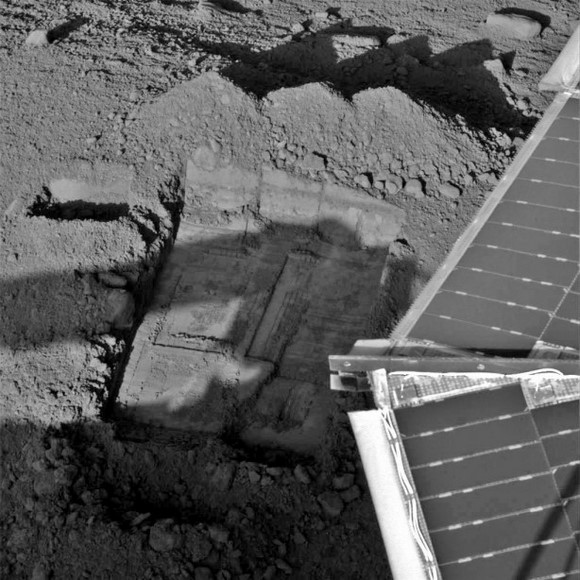If humans ever build a city on Mars, perhaps (in its retirement) the Phoenix Lander can apply for a job with the city’s public works department to scrape ice off sidewalks. Phoenix has been trying to dig down deeper into the “Snow White” trench and has been digging, scooping and scraping the ice layer that earlier soil scooping exposed. The robotic arm team is working to get an icy sample into the Robotic Arm scoop for delivery to the Thermal and Evolved Gas Analyzer (TEGA). Ray Arvidson of the Phoenix team, known as the “dig czar,” said the hard Martian surface that Phoenix has reached is proving to be a difficult target, and compared the process to scraping a sidewalk. “We have three tools on the scoop to help access ice and icy soil,” Arvidson said. “We can scoop material with the backhoe using the front titanium blade; we can scrape the surface with the tungsten carbide secondary blade on the bottom of the scoop; and we can use a high-speed rasp that comes out of a slot at the back of the scoop.”
“We expected ice and icy soil to be very strong because of the cold temperatures. It certainly looks like this is the case and we are getting ready to use the rasp to generate the fine icy soil and ice particles needed for delivery to TEGA,” he said.
Scraping action produced piles of scrapings at the bottom of a trench on Monday, but did not get the material into its scoop, evidenced from images returned to Earth by the lander. The piles of scrapings produced were smaller than previous piles dug by Phoenix, which made it difficult to collect the material into the Robotic Arm scoop.
“It’s like trying to pick up dust with a dustpan, but without a broom,” said Richard Volpe, an engineer from NASA’s Jet Propulsion Laboratory, Pasadena, Calif., on Phoenix’s Robotic Arm team.
The mission teams are now focusing on use of the motorized rasp within the Robotic Arm scoop to access the hard icy soil and ice deposits. They are conducting tests on Phoenix’s engineering model in the Payload Interoperability Testbed in Tucson to determine the optimum ways to rasp the hard surfaces and acquire the particulate material produced during the rasping. The testbed work and tests on Mars will help the team determine the best way to collect a sample of Martian ice for delivery to TEGA.
The Phoenix team also continues to analyze results from the Wet Chemistry Lab, as a sample was delivered to the lab on July 6. Results should be forthcoming.
News Source: Phoenix News


How did they prevent soil contamination at the landing site by the descent thrusters?
Nasa should talk to a retired backhoe operator to get tips on scooping small piles
Ill prepared ? or were my expectations too high ?
Should have planned a drill to get soil/ice carrots instead of a scoop ; the problem they’re encountering was pretty predictable…
Hope they manage to get through this mess…
Once Phoenix landed successfully the mission has been dissappointing in it’s weak system design. With a little soil, sand, water and a freezer, anyone could have discovered flaws with a) shaking/pushing frozen dirt through a window screen (only slightly smaller than the 3mm screen grid on the lander) and b) scraping a block of frozen dirt with no means to pick up the shavings. We have certainly been spoiled with the stellar performance of the rovers, but these problems were at predictable and even to be expected.
I’d very much like to see an actual analysis showing water ice rather then a crude estimate of the rate of sublimation of chunks of dislodged ice. It’s good evidence for water, but is not conclusive without the analytical data. Samples “drying out before they reach the oven” is a little shaky. The percentage H2O in a scraped sample should be a relatively simple analysis. Why haven’t we seen it?
I like Sugarrat’s suggestion.
Funny to see how many armchair geologists are chiming in now.
Power tools, yea! The spirit of Tool Time is on Mars!